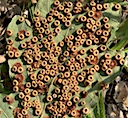 Silk Button Galls, one of the many kinds of galls found on our native oaks, really do look as if they have been spun from silken thread.
Silk Button Galls, one of the many kinds of galls found on our native oaks, really do look as if they have been spun from silken thread.
Photo: Amanda Scott
Scientific name: Neuroterus numismalis (this is the name of the parasitic gall-wasp that induces the galls)
What to look for:
• Appearance: Silk Button Galls are tiny (≤5 mm) and cup-shaped. Seen close to under a hand lens, it is possible to see the ‘embroidered’ raised edge. Reddish to golden yellow in colour, and often abundant across the underside of an oak leaf.
• Where: On native oak tree species.
• When: The Silk Button Galls appear on leaf undersides in autumn.
• Similar to: There are several kinds of small galls on oaks, including the Spangle Gall
 We are used to thinking of biodiversity as applying to whole landscapes and wider habitats, but it can just as equally apply to a metre-by-metre plot, or a single tree. One oak tree, for example, hosts far more creatures and plants than a large field in which a single crop is growing. Our native oak species have been with us since the last ice age, and since then have developed symbiotic and parasitic relationships with hundreds of other species. It is therefore not surprising that, of the 90 or so gall wasp species found in Britain, 42 are parasitic on oaks.
We are used to thinking of biodiversity as applying to whole landscapes and wider habitats, but it can just as equally apply to a metre-by-metre plot, or a single tree. One oak tree, for example, hosts far more creatures and plants than a large field in which a single crop is growing. Our native oak species have been with us since the last ice age, and since then have developed symbiotic and parasitic relationships with hundreds of other species. It is therefore not surprising that, of the 90 or so gall wasp species found in Britain, 42 are parasitic on oaks.
One common oak gall is the rather lovely Silk Button Gall, created by the parasitic gall wasp Neuroterus numismalis on our native oak species. These galls are often abundant, clustering together on the underside of individual leaves in large groups. If you can, look at them closely using a hand lens, and you can see how the raised, rounded edge of the gall looks as if it has been spun using fine golden silk.
 Each of these tiny galls hosts a larva. The galls fall off the leaves in winter, or fall with them to the ground in the autumn. In spring, the adults emerge – this is an asexual generation, which proceeds to lay eggs in the oak buds. The larvae that hatch from these induce galls in the newly forming leaves. These galls, called Blister Galls, are green and flatter, so much harder to spot. When the larvae mature, they hatch as the sexual generation in early to mid-summer, and so the cycle continues.
Each of these tiny galls hosts a larva. The galls fall off the leaves in winter, or fall with them to the ground in the autumn. In spring, the adults emerge – this is an asexual generation, which proceeds to lay eggs in the oak buds. The larvae that hatch from these induce galls in the newly forming leaves. These galls, called Blister Galls, are green and flatter, so much harder to spot. When the larvae mature, they hatch as the sexual generation in early to mid-summer, and so the cycle continues.
Oak trees are not generally adversely affected by the presence of Silk Button Spangle Galls. In mast years (years when an abundance of acorns are produced), the oaks put most of their energy into fruiting, so they may be more susceptible to infestation. Generally, however, they recover well in the next year.
Did you know…?
…Galls are chemically induced to form by the developing grubs
More information and references:
Chinery, M., 2011. Britain’s Plant Galls. A Photographic Guide. WildGuides Ltd., Hampshire.
Redfern, M. and Shirley, P., 2011. British Plant Galls (second edition). Field Studies Council, Shropshire.
Published: September 2020
Author: Amanda Scott
Photos: Amanda Scott
